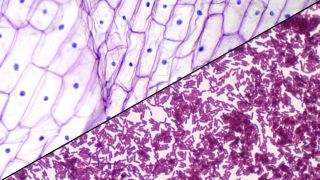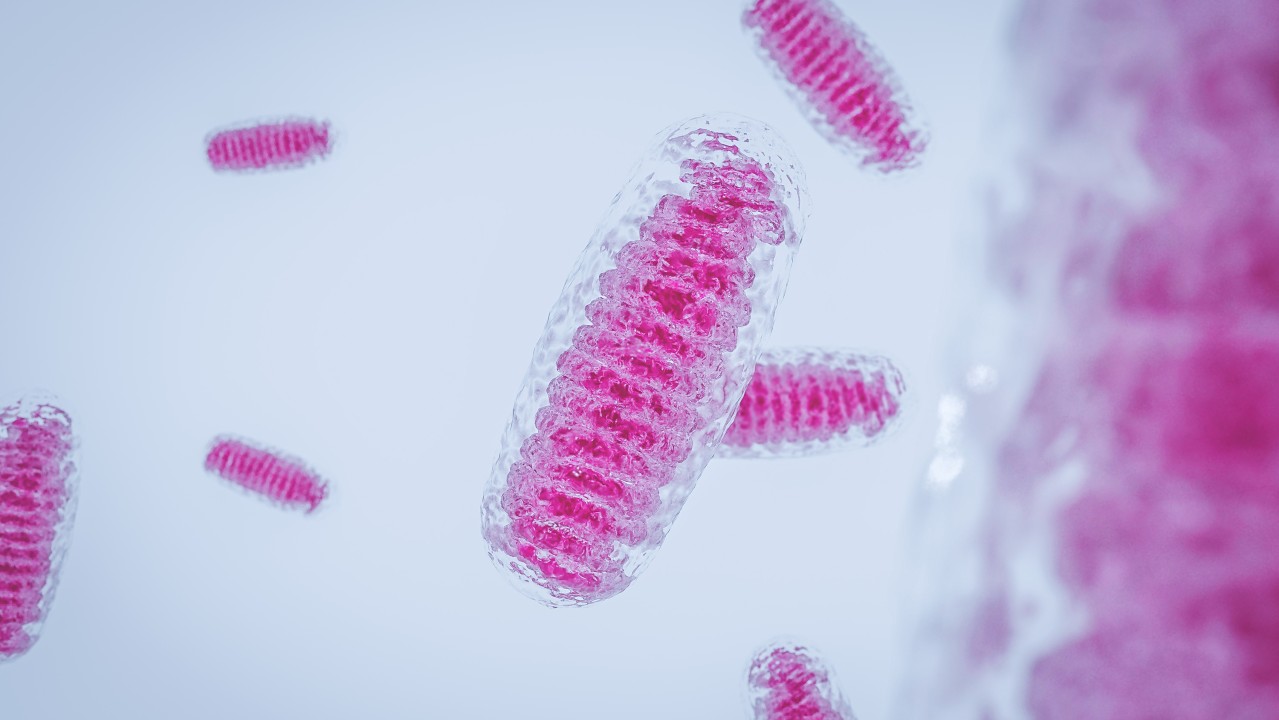How Do You Know That Yeasts Are Eukaryotic and Not Prokaryotic
What is the deviation between prokaryotic and eukaryotic cells?

The main difference between prokaryotic and eukaryotic cells lies in their structure.
Prokaryotic cells and eukaryotic cells are the two types of cells that be on Earth. In that location are several differences between the two, but the biggest distinction betwixt them is that eukaryotic cells have a singled-out nucleus containing the cell's genetic material, while prokaryotic cells don't accept a nucleus and have gratis-floating genetic textile instead.
What are prokaryotic and eukaryotic cells?
All living things can be divided into three basic domains: Bacteria, Archaea and Eukarya. The primarily single-celled organisms found in the Bacteria and Archaea domains are known as prokaryotes. These organisms are made of prokaryotic cells — the smallest, simplest and almost ancient cells.
Organisms in the Eukarya domain are made of the more than circuitous eukaryotic cells. These organisms, called eukaryotes, can be unicellular or multicellular and include animals, plants, fungi and protists. Many people are unclear on whether yeasts or fungi are prokaryotes or eukaryotes. Both are eukaryotes and share similar cell structure to all other eukaryotes.
There is evidence to suggest that eukaryotes are the descendants of separate prokaryotic cells, co-ordinate to Berkeley University of California.
Eukaryotes developed at least 2.7 billion years ago, following i to 1.v billion years of prokaryotic development, according to the National Institutes of Wellness (NIH). Scientists hypothesize that the nucleus and other eukaryotic features may accept offset formed after a prokaryotic organism swallowed upwards another, co-ordinate to the Academy of Texas.
It's too been suggested that tiny organelles in eukaryotic cells – called mitochondria – may also be the descends of prokaryotic living-bacterium which were engulfed by other cells and remained in the prison cell as a permanent guest, according to Berkeley University.
What practice prokaryotes and eukaryotes have in common?
Although prokaryotic and eukaryotic cells accept many differences, they share some common features, including the following:
- Dna: Genetic coding that determines all the characteristics of living things.
- Cell (or plasma) membrane: Outer layer that separates the cell from the surrounding environs and acts as a selective bulwark for incoming and approachable materials.
- Cytoplasm: Jelly-like fluid within a cell that is equanimous primarily of water, salts and proteins.
- Ribosomes: Organelles that brand proteins.
How practice prokaryotes and eukaryotes differ?
Eukaryotic cells accept a nucleus surrounded by a nuclear envelope that consists of two lipid membranes, according to Nature Education. The nucleus holds the eukaryotic cell'due south DNA. Prokaryotic cells practise not have a nucleus; rather, they have a membraneless nucleoid region (open office of the prison cell) that holds free-floating Deoxyribonucleic acid, according to Washington University.
The entire Deoxyribonucleic acid in a cell can be found in individual pieces known equally chromosomes. Eukaryotic cells have many chromosomes which undergo meiosis and mitosis during cell division, while most prokaryotic cells consist of just i circular chromosome. Still, recent studies have shown that some prokaryotes take as many every bit iv linear or circular chromosomes, according to Nature Education. For example, Vibrio cholerae, the bacterium that causes cholera, has 2 circular chromosomes.
Eukaryotic cells have several other membrane-bound organelles not constitute in prokaryotic cells. These include the mitochondria (convert food energy into adenosine triphosphate, or ATP, to power biochemical reactions); crude and smooth endoplasmic reticulum (an interconnected network of membrane-enclosed tubules that send synthesized proteins); golgi complex (sorts and packages proteins for secretion); and in the case of plant cells, chloroplasts (conduct photosynthesis). All of these organelles are located in the eukaryotic cell'due south cytoplasm.

Although just eukaryotes carry membrane-leap organelles, recent evidence suggests that both eukaryotes and prokaryotes can produce organelle-like structures that lack membranes, according to a 2020 report published in the journal Proceedings of the National Academy of Sciences (PNAS).
For instance, in the bacterium Escherichia coli, molecules and proteins cluster together to grade liquid "compartments" within the cytoplasm, according to the PNAS report. These compartments grade similarly to how oil forms droplets when mixed with h2o, co-ordinate to a statement from the Academy of Michigan. Such membraneless structures accept been reported in many bacterial species, including Mycobacterium tuberculosis, which causes tuberculosis, and cyanobacteria, a type of photosynthetic bacteria that can besides crusade affliction.
In eukaryotic cells, the ribosomes are bigger, more complex and jump by a membrane. They can exist plant in various places: Sometimes in the cytoplasm; on the endoplasmic reticulum; or attached to the nuclear membrane (covering on the nucleus).
In prokaryotic cells, the ribosomes are scattered and floating freely throughout the cytoplasm. The ribosomes in prokaryotic cells also have smaller subunits. All ribosomes (in both eukaryotic and prokaryotic cells) are made of two subunits — 1 larger and ane smaller. In eukaryotes, these pieces are identified past scientists as the 60-South and 40-South subunits. In prokaryotes, the ribosomes are made of slightly smaller subunits, called 50-S and thirty-S.
The difference in types of subunits has allowed scientists to develop antibiotic drugs, such as streptomycin, that attack certain types of infectious leaner, according to the British Gild for Cell Biology. On the downside, some bacterial toxins and the polio virus utilise the ribosome differences to their advantage; they're able to identify and attack eukaryotic cells' translation mechanism, or the process past which messenger RNA is translated into proteins.
Most eukaryotes also reproduce sexually (although some protists and unmarried-celled fungi may reproduce through mitosis, which is functionally like to asexual reproduction). Prokaryotes reproduce asexually, resulting in the offspring being an exact clone of the parent. Some prokaryotic cells likewise take pili, which are adhesive hair-like projections used to substitution genetic fabric during a blazon of sexual process called conjugation, according to Concepts of Biology. Conjugation can occur in leaner, protozoans and some algae and fungi.
Most prokaryotic cells have a rigid cell wall that surrounds the plasma membrane and gives shape to the organism. In eukaryotes, vertebrates don't have a cell wall but plants do. The prison cell walls of prokaryotes differ chemically from the eukaryotic prison cell walls of establish cells, which are primarily fabricated of cellulose. In bacteria, for example, the cell walls are composed of peptidoglycans (sugars and amino acids), co-ordinate to Washington University.
Boosted resources
Check out this blithe video by the Amoeba Sisters that explains the difference betwixt prokaryotic and eukaryotic cells. To take a more indepth expect into all the cells in the globe take a look at Looking Inside Cells: Life Science past Kimerberly Fekany Lee.
Bibliography
Lesli J Favor, "How Eukaryotic and Prokaryotic Cells Differ (Britannica Guide to Jail cell Biology)," Rosen Publishing, 2014.
Frantisek Baluska et al, "Eukaryotic Cells and their Cell Bodies: Cell Theory Revised", Annals of Botany, Book 94, Jukly 2004, https://doi.org/10.1093/aob/mch109
James Wagstaff & Jan Lowe, "Prokaryotic cytoskeletons: protein filaments organizing small cells", Nature Reviews Microbiology, Book 16, January 2018, https://doi.org/10.1038/nrmicro.2017.153
Avadhesha Surolia & Abhijit Chakrabarti, "Biochemical Roles of Eukaryotic Cell Surface Macromolecules", Springer International Publishing, 2014.
Source: https://www.livescience.com/65922-prokaryotic-vs-eukaryotic-cells.html
0 Response to "How Do You Know That Yeasts Are Eukaryotic and Not Prokaryotic"
Postar um comentário